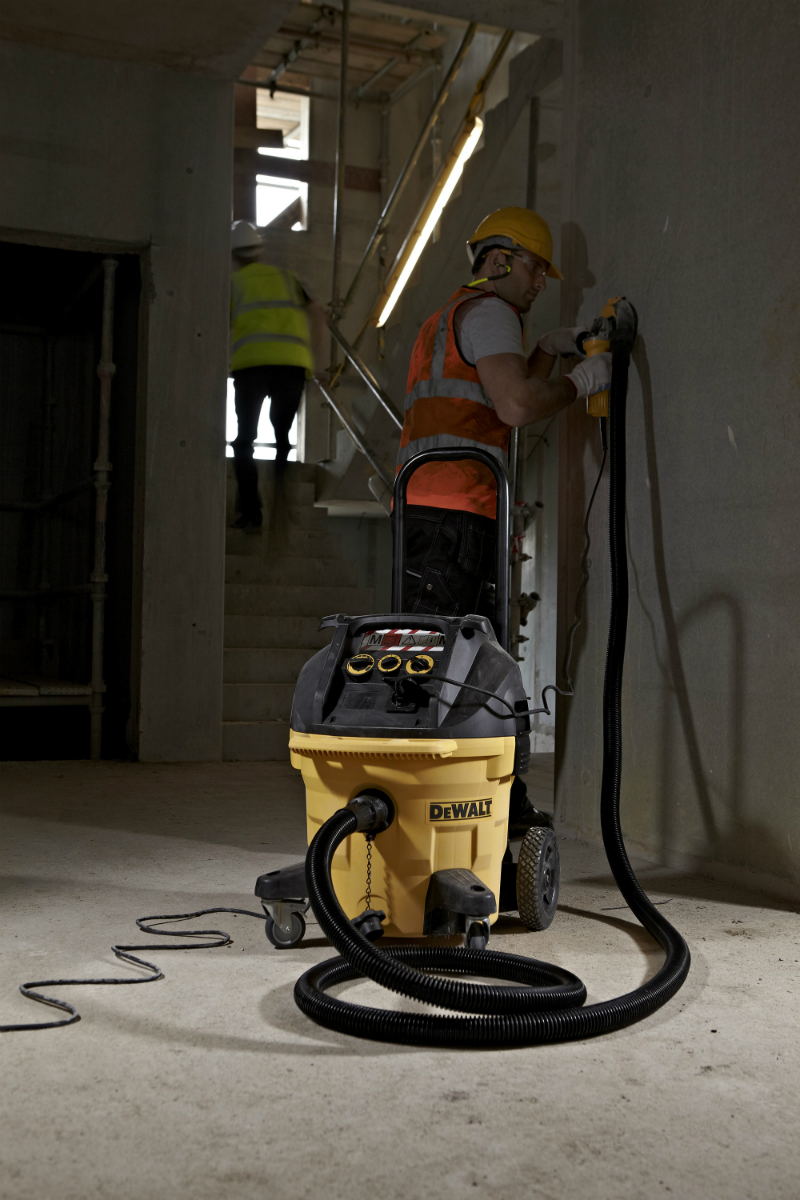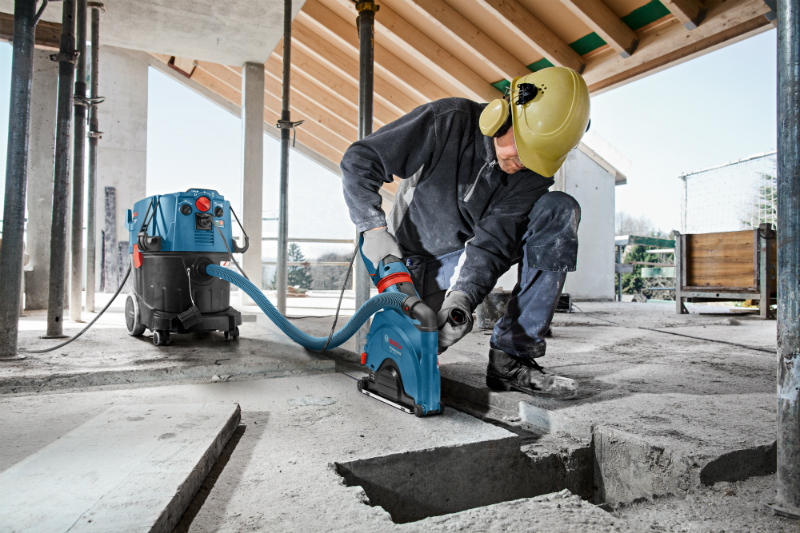
Dust Extractor Buying Guide
Dust Extractors: 30-Second Buying Guide
| Brand | Model | Type | Price |
|---|---|---|---|
| DEWALT | DCV100 | Blower | £70 |
| MAKITA | DVC750LZ | Vacuum cleaner | £152 |
| MAKITA | DCL180Z | Vacuum cleaner | £57 |
| MAKITA | VC2012L | Vacuum cleaner | £212 |
| MAKITA | VC4210MX/1 | M class dust extractor | £671 |
| DEWALT | DCV517N | M class dust extractor | £126 |
| MAKITA | VC2512L | M class dust extractor | £174 |
Things to consider when buying a Dust extractor:
- Level of protection – what type of dust do you need to remove?
- Power source – is the dust extractor cordless, mains 110v (for work sites), or mains 240v (for home use)?
- Wet or dry pick up – do you need the dust extractor to remove liquids as well as dry solids?
- Power take-off required – are you limited on the amount of plugs?
- Auto on/off – do you need the dust extractor to only work while using a tool?
- Capacity – how much dust will be created by your work?
- Auto clean– this function can make the level of filtration more reliable
Dust extractors - Extracting the Main Points
Types of Dust Extractor- Dust extractors: Any job that involves cutting, drilling or sanding will undoubtedly cause waste, from fine dust to chippings. Dust extractors help to improve the air quality and hence the safety of those in the area. They can also help to protect your power tools from damage. Dust extractors are frequently used by tradespeople that work with wood. There are a lot of choices of dust extractors so making sure you have the right one can be a daunting decision. The first thing to ascertain is the type of material that you will working on, and the waste that can be generated from it. All of the dust extractors that we stock are portable in that they can be moved around with relative ease. They are designed to work with power tools and can be attached to most dust ports on power tools, either directly or by means of an adaptor. They come in different classes - L (Low), M (Medium), H (High), which are explained in more detail below.
Our most popular Dust extractor: MAKITA DVC750LZ (£152)
- Vacuum cleaners: are a general use machine also known as hoovers. They are for general waste management around the home and office. They cannot deal with the quantities or size of waste that dust extractors can, and generally will not provide a similar level of filtration.
Key Considerations When Buying A Dust Extractor
Level of protection: Dust Extractors come in three main classes - L, M and H. These classes refer to the filtration level on the dust extractor, which helps determine whether the machine is suitable for extracting specific materials or dusts. The table below shows the efficiency of each classification. The percentage leakage is the maximum amount of hazardous dust that can penetrate back through the filter when being used. For example, with an L-class dust extractor, the table shows that 99% of the dust should be removed by the extractor being used.
Workplace Exposure Limit (WEL) is set by the Health & Safety Executive (HSE) and defines the maximum amount of many substances that can be present in air within the workplace. As a result of this, within most work sites, M-class dust extractors must be used as a minimum, as they can cope with higher hazard substances such as wood and silica.
Dust Extractor classifications
As you can see from the table, L-class dust extractors provide the lowest level of filtration and the best level of filtration is provided by H-class dust extractors. L-class dust extractors are suitable for dealing with general dust and soil, but they are not for use when any of the waste can be harmful - such as wood dust. They also don't have some of the safety features that M and H-class extractors have. For example M and H dust extractors often have an indicator that shows if the air velocity drops below a certain speed, a way of emptying dust containers so that no dust escapes, and a robust filter that won't easily puncture.Class Suitable for hazardous dusts Filter Leakage - as % of collected dust L class With a WEL greater than 1.0 mg/m3 Less than 1% M Class With a WEL greater than or equal to 0.1mg/m3 Less than 0.1% H Class With a WEL less than 0.1 mg/m3 including carcinogenic dusts and dusts contaminated with carcinogens and/or pathogens Less than 0.005% Vacuum cleaners do not offer any protection against harmful substances and so are not suitable for use with power tools.
 Power source: Dust extractors come in either 240v (for home use), 110v (for site use) or cordless 18v options. Most of the cordless options currently only offer class L protection so if you require a higher level then you will typically have to choose a mains machine.
Power source: Dust extractors come in either 240v (for home use), 110v (for site use) or cordless 18v options. Most of the cordless options currently only offer class L protection so if you require a higher level then you will typically have to choose a mains machine.There are a few brands that supply small extractors that fit onto their cordless SDS+ drills. These extractors work from the same battery that is used to power the machine. They have HEPA (High Efficiency Particulate Absorption) filters fitted which offer a better level of protection than standard vacuums. The advantage of these extractors is that they are extremely portable and do not require any hoses to connect to. However the HEPA filters on these types of extractor don't offer the same level of filtration as a dust extractor, nor a way of maintaining constant filtration levels.
Wet or dry pick up: Some dust extractors can pick up wet and dry materials. This is especially useful when working in a workshop where spillages could occur.
Power take-off: Some dust extractors come with a power take-off point. This enables the user to only require one plug socket (for the dust extractor), as the power tool itself can plug directly into the dust extractor. However, you must check that the wattage of the power tool you wish to plug in is supported with the wattage of the power take-off point on the dust extractor. The wattage of the power tool will likely be different to that of the dust extractor. If you make use of the power take-off feature then the dust extractor can be set so that it will only turn on when the machine is in use and then turn off automatically. The power take-off on some dust extractors are configured to continue to run for approximately 15 seconds after the power tool stops to help ensure as much dust is removed from the air as possible.
Auto on/off: Some dust extractors have a function that automatically runs with the machine in use. This used to be unique to extractors that only had a power take off point but with recent advances there are dust extractors that can do this with cordless machines too. The dust extractors are connected to the power tool via Bluetooth and will automatically know when the power tool is in use or not. This feature can help minimise the amount of noise and power used.
Capacity: Dust extractors have varying storage capacity size. They often range from 5 to 50 litres, but some can hold even more waste. Obviously the greater the capacity the larger the machine. As a general rule, cordless dust extractors will be smaller but with battery technology advancing this may not always be the case. If you are working with power tools that primarily create a lot of chippings (such as planers) then the larger the tank the better, as they are likely to produce larger waste particles. Having a larger capacity dust extractor will mean that you can save time by emptying the tank on fewer occasions during the day. If you move around a lot during the day then maybe a smaller capacity dust extractor would be better, as it would likely be a smaller and more portable machine.
Auto Clean: Some class M and L extractors come with an auto clean function for the filters. They usually have two filters that work side by side. When one is cleaning the other one carries on filtering the harmful substances. This means that you spend less time cleaning the filter and can be more confident that the machine is protecting you to the best of its ability.
Dust Extractor Safety Tips

Dust Extractors themselves are not particularly dangerous, but they can be dangerous to people's health if they are used on hazardous substances they are not intended for. Make sure you have the correct class of dust extractor for the dust you are creating or waste you are removing. Also ensure that there is a tight connection between the hose and tool adaptor to ensure all waste is filtered correctly.
View our range of Dust extractors and find the lowest prices online at Howe Tools.


